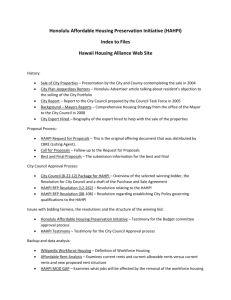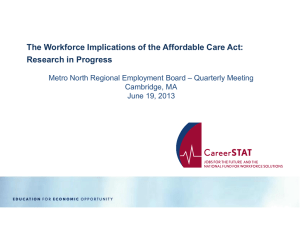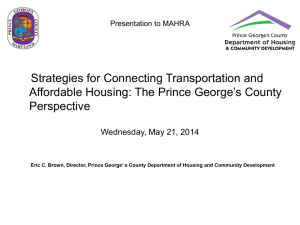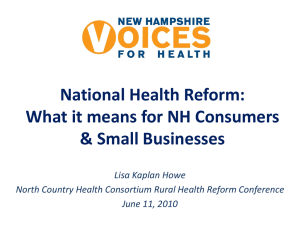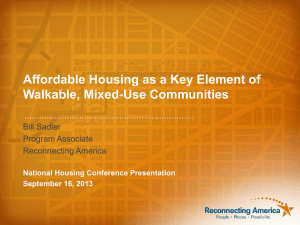Building Sustainable Housing Around TOD
advertisement
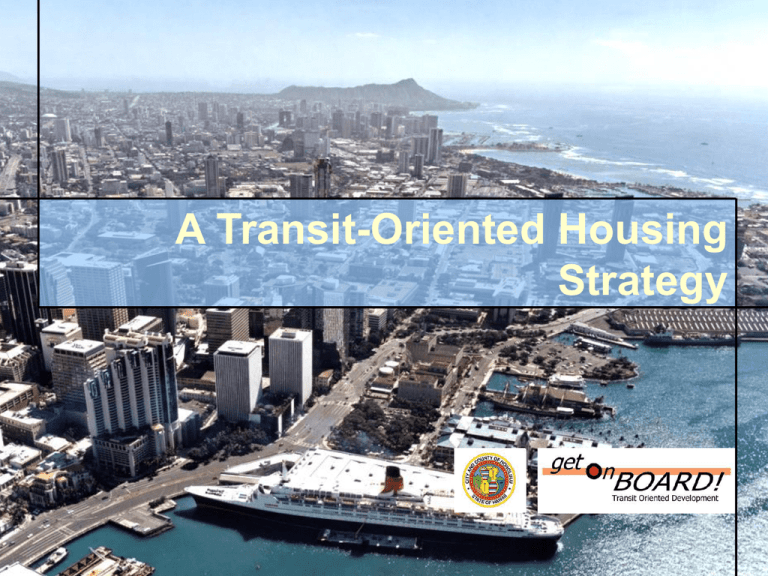
A Transit-Oriented Housing Strategy Creating A Transit-Oriented Workforce Housing Strategy for Honolulu Housing Mosaic Capital Wage Market Income Demand Labor Public Policy Materials Land Job Growth Regional Approach Goal: Increase Workforce Housing near Transit Creating A Transit-Oriented Workforce Housing Strategy for Honolulu Source: The Center for Transit-Oriented Development Breaking the Cycle of Unintended Consequences in Transit-Rich Neighborhoods Market Trends Construction Costs Comparison Source: Rider Levitt Bucknall Workforce Housing Source: Center for Housing Policy, 2009 Housing, Rents, and Income Data Average Hourly Earnings, Selected Industries 35.00 30.00 2005 25.00 2006 20.00 2007 15.00 2008 2009 10.00 5.00 0.00 Source: Hawaii State Data Book, 2009 Distribution of Honolulu Household Demand vs. Supply by HUD AMI Levels > 180% AMI 100.0% 12.3% 23.6% 80.0% 60.0% 7.4% 11.7% 58.7% 13.8% 25.6% 13.1% 40.0% 20.0% 0.0% 10.0% 20.3% 18.0% 3.7% Single Family Demand 9.6% 8.5% 8.9% 30.3% 141 - 180% AMI 121 - 140% AMI 81 - 120% AMI 51 - 80% AMI 20.9% 10.5% 7.4% 1.9% 0.4% 0.1% Single Family Supply 21.8% 8.5% 10.2% Multi Family Demand 31.4% 8.5% 2.9% Multi Family Supply 30 - 50% AMI < 30% AMI Combined Housing and Transportation Costs % of Household Income 70.0% 60.0% 50.0% 20.4% 18.6% 40.0% 21.3% 21.5% 21.0% 21.4% 22.6% 15.0% Housing 30.0% 20.0% 35.0% 32.0% 28.6% 26.3% 10.0% 33.0% 27.0% 32.2% 29.2% co e n Fr a nc is at tl Sa Di e n Sa Se go ix oe n ak e lt L Ph ity C an d Source: http://htaindex.cnt.org Sa Po rtl le s An ge Lo s on o lu l u 0.0% H Transportation Definitions • Affordability – Pay no more than 30% of Gross Monthly Income. Housing meets needs of households • Area Median Income – At 100% of AMI, half residents earn below that amount and half above • Very Low Income - <30% of AMI • Low Income – 30% to 59% of AMI • Moderate Income – 60% to 79% AMI • Middle Income – 80% to 120% of AMI Market Trends • New real estate development in Honolulu is challenged by high construction costs which result from: – Strong labor unions and associated high cost of labor • Although recent declines in construction activity have reduced labor rates – military construction projects continue to support Oahu’s relatively high construction wages – High cost of land • Approximately 1% of Hawaii’s land is developable; • The supply of developable land is constrained by: – Mountains – Military owned lands – State of Hawaii owned lands – Privately-owned lands – Premium cost of materials which usually must be imported • Hawaii does not have plentiful natural resources that are generally used in traditional building materials – Other factors • Expectation that developers pay for infrastructure upgrades • Length of time required for permit and entitlement review timeline • Zoning considerations (i.e. green space and parking requirements) Factors That Affect the Amount of Travel & Modal Choice Automobile Transit Cycling & Walking Out-of-Pocket Costs Fuel & Maintenance Roadway Tolls Parking Fees Transit Fare Maintenance Time Costs Driving Parking Search Walking Walking Waiting Riding Riding Walking Service Attributes Effort Safety Comfort Effort Safety Comfort Effort Safety Comfort Short & Long-term Effects of Transportation System Improvements Work and non-work travel (frequency, destination, Short-term decisions mode) Transportation Automobile ownership improvement Mode to Work Employment location Residential location Infrastructure investment Medium-term decisions Long-term decisions Potential Livability Benefit Outcomes associated w/TOD Downtown & Neighborhood Rejuvenation Metropolitan Sustainability & VMT Reduction Social Equity for Jobs & Housing Economic Growth with Environmental Quality TOD 3.0 1. Route Alignment 2. Station Location 3. Station Area 4. Land Assemblage 5. Infrastructure 6. Vertical Development 7. Livability Benefits Challenge: TOD Housing Difficult, Time-Consuming, and Expensive Land Prices Land prices around station are likely to increase because of speculation when a new transit line is planned Affordable and workforce housing developers lack the capital to acquire land before the prices go up and hold it until ready to be developed Financing Funding for workforce housing is limited or too restrictive Mixed-income and mixed-use projects require complex financing structures involving multiple sources of funding Timeline Sites often require land assembly and rezoning, leading to lengthy acquisition and permitting process Community opposition to density and affordable housing can be challenging Development near transit requires collaboration among the public, private, and non-profit sectors , which can be difficult to coordinate given the different needs, constraints, and schedules Creating A Transit-Oriented Workforce Housing Strategy for Honolulu Source: Center for Transit-Oriented Development Housing Challenges 1. Affordable housing and rental housing, both have negative connotation – NIMBY’s. 2. Typically, projected market rents do not support new multi-family (rental )construction; 3. Hawaii is dominated by service-sector industries, whose average employee wage scales do not support the purchase of housing (for-sale) 4. The majority of employer assisted housing programs focus heavily on demand-side (for-sale) programs. PARTNERSHIP APPROACH: Collective, long-term, sustained, and strategic investments are needed in order to produce important community development outcomes. In addition to brokering a common agenda, these partnerships are building the capacity of community-based groups and other stakeholders to ensure strong local leadership. These coalitions help increase the flow of resources into neighborhoods, define and execute market-based strategies, and develop new approaches to creating and seizing neighborhood development opportunities. aggressive land assembly partnership approach regional connections housing development/ rehab tools targeted neighborhood planning economic development sophisticated market analysis marketing neighborhoods procedures that measure impact Community Challenge Planning Grant $40 million total – Honolulu receieved $2.3m max grant + 20% match) to: Foster reform and reduce barriers to achieving affordable, economically vital, and sustainable communities. • Development of master plans or comprehensive plans that promote affordable housing co-located and/or well connected w/retail, businesses..aligned w/..transportation plans; •Development & implementation of plans and strategies that promote livability and sustainability; • Revisions to zoning codes, ordinances, building standards, or other laws to remove barriers…..; •Revisions to building codes to promote …energy efficiency….; •Strategies for creating or preserving affordable housing for low, very-low, and extremely-low families or individuals….; •Strategies to bring additional affordable housing to areas that have few housing opportunities….; •Planning, establishing, and maintaining acquisition funds and/or land banks for development, redevelopment, and revitalization for the development of affordable housing Goal: Increase Workforce Housing Along the Rail Corridor 1. Truly Affordable Housing – Pairing lower housing costs with lower transportation costs 2. Broadening Access To Opportunity – Producing better economic and social outcomes 3. Increasing Employers’ Access To Metro Workforce – Improving economic competitiveness and productivity 4. Stabilizing “High-Percentage” Riders – Increasing transit access to populations who will use it the most 5. Alleviating Gentrification Pressures Near Transit Stations – Counterbalance the potential displacement of existing workforce housing Creating A Transit-Oriented Workforce Housing Strategy for Honolulu Build On Multiple State, Local Housing Studies 2008 Comprehensive Housing Strategy for the C&C of Honolulu, Mayor’s Affordable Housing Advisor Group State-level Recommendations Change purpose of the Land Use Commission to long-term planning Modify Low Income Housing Tax Credit allocation and requirements County-level Recommendations 2008 Report of the Governor’s Affordable Housing Regulatory Barriers Task Force Establish county-level Office of Housing and provide a single government point-of-contact for housing development (Ongoing) Increase long-range housing planning capability at DPP Streamline the entitlement process to reduce length, cost Nine additional studies and reports conducted between Revise rules for Unilateral Agreements to 140% of AMI, transfer/sale of housing credits, and 1991 and 2006 by federal, enhancement credits. (Complete) state, and local agencies Fee-based expedited third-party review by private consultants (Complete) Plan/budget for infrastructure investment with Honolulu High-Capacity Transit Corridor Project and Creating A Transit-Oriented Workforce Housing Strategy for Honolulu TOD Strategies 1. Focus on creating mixed-income workforce housing opportunities near transit . 2. Engage employers and employee unions to expand employer assisted rental housing programs; 3. Focus on preservation of existing housing units and; opportunities for acquisition and rehabilitation/adaption of existing structures; 4. Actively pursue modifications to state and local regulatory policies to reduce impediments to create more affordable, energy-efficient housing. Integrated, Targeted Approach for TOD Housing Planning and Zoning Financing Inclusionary Zoning Expedited Permitting Reduced Parking Requirements Modify Unilateral Agreements Land Acquisition/Banking Fund Pre-development Financing Gap Financing Preservation/Rehabilitation Financing Modify LIHTC criteria Incentives Coordination Density Bonus Impact Fee Waivers Property Tax Waiver Tax Abatement TOD Housing Coordinator Public-Private Partnerships Value Capture Tools For Infrastructure Programming Capacity Creating A Transit-Oriented Workforce Housing Strategy for Honolulu TOD Fund Structure and Activities • Enhance impact, funding through collaboration – Use HUD funding for “top loss” or lead equity capital – Identify fund manager and define transactional role – Provide start-up support while structuring the fund – Create governance agreement to guide fund mission and mechanics – Solicit partners to build “capital stack” and mitigate risk Creating A Transit-Oriented Workforce Housing Strategy for Honolulu Land Acquisition/Banking Fund for TOD • Buy and hold strategic parcels before the real estate market heats up to control development later and ensure it meets community development goals • Do catalytic projects to help “jumpstart” markets and help transition auto-oriented places into compact, walkable, transit-oriented places • Ensure that existing affordable housing is preserved and new affordable housing is created—along with other important amenities—in valuable transit-rich locations • Target small projects where preservation/development of affordable housing units is possible Source: Center for Transit-Oriented Development Land Acquisition/Banking Fund for TOD Case Study: Case Study: Denver Transit-Oriented Development Fund Portland TOD Property Tax Abatement $15m credit facility focused on preserving and creating affordable housing with access to transit Supports TOD by reducing operating costs through a 10-year maximum property tax exemption Public-private partnership with Enterprise Community Partners and the Urban Land Conservancy Applies to newly-constructed structures, additions or conversions within ¼ mile of transit Provides capital for non-profits to leverage for purchase, operation, and rehabilitation of affordable housing Minimum of 10 units, 20% at 60 percent of AMI, 10% at 30 percent of AMI 100% Loan to Value Ratio, 5-year hold on property, and risk mitigation with “top loss” pool Creating A Transit-Oriented Workforce Housing Strategy for Honolulu Sponsor must own or have site control and demonstrate exemption necessary for financial feasibility Annual cap of $20m for 3 years Denver Transit-Oriented Development Fund City & County Of Denver Enterprise Communities Housing Finance Authority & Foundations Capital Sources Capital Stack or Waterfall Manager Commercial Enterprise Lenders Communities Bridging Foundations the Gap Local Government CHFA Senior Debt CDFI Fund DURA DHA Borrowers Urban Land Conservatory Take-out Financing Joint Venture Structure CDC • Affordable Housing Operator/ Manager •Workforce Placement •Social Services Private developer •Land owner •Conceptualization •Financing •Entitlements •Construction •Operations, Leasing & Management City & County of Honolulu •Planning & Zoning •Permitting •Community Outreach •Affordable housing •Transportation •Infrastructure Financing City & County Private Developer of Honolulu Market-driven Maximize community benefits Infill Minimize environmental impacts Mixed-use Provide services Proximity to transit Protect public health & safety • Return on Investment • Minimize risk • Create long-term value Community Needs •Mixed-income, •affordable housing •Neighborhood services •Job creation •Social & economic equity •Infrastructure GAP Creating the Implementing Entity – a local CDC • The term CDC refers to a type of non-profit entity known as a "community development corporation". CDC’s are characterized by their community-based leadership and their work primarily in housing production and/or job creation. This is what differentiates them from other types of non-profit groups. • CDC’s are formed by residents, small business owners, congregations and other local stakeholders to revitalize a low- and/or moderateincome community. CDC’s typically produce affordable housing and create jobs for community residents. Jobs are often created through small or micro business lending or commercial development projects. Some CDC’s also provide a variety of social services to their target area. • A CDC is organized under section 501 (c) (3) of the Internal Revenue Code like any other non-profit entity . Local residents form the CDC getting together and developing a set of by-laws, file for incorporation with the state government and apply to the federal Internal Revenue Service (IRS) for designation as a tax exempt non-profit organization. The IRS designation is necessary in order for the organization to obtain grants and gifts from any government, corporate, or foundation sources or from individuals. Roles & Responsibilities EDA SBA Consultants •Organization •Development •Financing US Treasury •LIHTC •NMTC HUD • HOME • CDBG • Sec 108 Private Lenders •Banks •REIT’s City & County of Honolulu • Community Services •Economic Development •Planning & Permitting Private Entities/ Foundations •LISC •Enterprise Foundation •NeighborWorks •Living Cities CDC • Affordable Housing •Wealth Building •Community Transformation •Asset Management Roles & Responsibilities Consultants •Organization •Development •Financing City & County of Honolulu Expertise • Community Services •Economic Development Oversight •Planning & Permitting Private Entities/ Foundations •LISC •Enterprise Foundation •NeighborWorks •Living Cities CDC Limited Liability Partnership Vision Neighbor Management - hood Investment partners residents Shareholders
